Naturally occurring triggers that induce apoptosis-like programmed cell death in Plasmodium berghei ookinetes
- PMID: 20844583
- PMCID: PMC2936559
- DOI: 10.1371/journal.pone.0012634
Naturally occurring triggers that induce apoptosis-like programmed cell death in Plasmodium berghei ookinetes
Abstract
Several protozoan parasites have been shown to undergo a form of programmed cell death that exhibits morphological features associated with metazoan apoptosis. These include the rodent malaria parasite, Plasmodium berghei. Malaria zygotes develop in the mosquito midgut lumen, forming motile ookinetes. Up to 50% of these exhibit phenotypic markers of apoptosis; as do those grown in culture. We hypothesised that naturally occurring signals induce many ookinetes to undergo apoptosis before midgut traversal. To determine whether nitric oxide and reactive oxygen species act as such triggers, ookinetes were cultured with donors of these molecules. Exposure to the nitric oxide donor SNP induced a significant increase in ookinetes with condensed nuclear chromatin, activated caspase-like molecules and translocation of phosphatidylserine that was dose and time related. Results from an assay that detects the potential-dependent accumulation of aggregates of JC-1 in mitochondria suggested that nitric oxide does not operate via loss of mitochondrial membrane potential. L-DOPA (reactive oxygen species donor) also caused apoptosis in a dose and time dependent manner. Removal of white blood cells significantly decreased ookinetes exhibiting a marker of apoptosis in vitro. Inhibition of the activity of nitric oxide synthase in the mosquito midgut epithelium using L-NAME significantly decreased the proportion of apoptotic ookinetes and increased the number of oocysts that developed. Introduction of a nitric oxide donor into the blood meal had no effect on mosquito longevity but did reduce prevalence and intensity of infection. Thus, nitric oxide and reactive oxygen species are triggers of apoptosis in Plasmodium ookinetes. They occur naturally in the mosquito midgut lumen, sourced from infected blood and mosquito tissue. Up regulation of mosquito nitric oxide synthase activity has potential as a transmission blocking strategy.
Conflict of interest statement
Figures
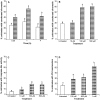

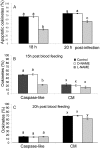
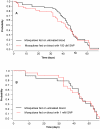
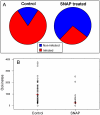
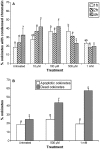
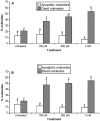
Similar articles
-
SOAP, a novel malaria ookinete protein involved in mosquito midgut invasion and oocyst development.Mol Microbiol. 2003 Jul;49(2):319-29. doi: 10.1046/j.1365-2958.2003.03566.x. Mol Microbiol. 2003. PMID: 12828632
-
Apoptosis in the malaria protozoan, Plasmodium berghei: a possible mechanism for limiting intensity of infection in the mosquito.Int J Parasitol. 2002 Aug;32(9):1133-43. doi: 10.1016/s0020-7519(02)00087-5. Int J Parasitol. 2002. PMID: 12117496
-
Variation in apoptosis mechanisms employed by malaria parasites: the roles of inducers, dose dependence and parasite stages.Malar J. 2012 Aug 28;11:297. doi: 10.1186/1475-2875-11-297. Malar J. 2012. PMID: 22929459 Free PMC article.
-
The role of programmed cell death in Plasmodium-mosquito interactions.Int J Parasitol. 2004 Dec;34(13-14):1459-72. doi: 10.1016/j.ijpara.2004.10.002. Int J Parasitol. 2004. PMID: 15582523 Review.
-
Do malaria ookinete surface proteins P25 and P28 mediate parasite entry into mosquito midgut epithelial cells?Malar J. 2005 Feb 25;4:15. doi: 10.1186/1475-2875-4-15. Malar J. 2005. PMID: 15733320 Free PMC article. Review.
Cited by
-
Sex and death: the effects of innate immune factors on the sexual reproduction of malaria parasites.PLoS Pathog. 2011 Mar;7(3):e1001309. doi: 10.1371/journal.ppat.1001309. Epub 2011 Mar 3. PLoS Pathog. 2011. PMID: 21408620 Free PMC article.
-
The Plasmodium bottleneck: malaria parasite losses in the mosquito vector.Mem Inst Oswaldo Cruz. 2014 Aug;109(5):644-61. doi: 10.1590/0074-0276130597. Mem Inst Oswaldo Cruz. 2014. PMID: 25185005 Free PMC article.
-
On Programmed Cell Death in Plasmodium falciparum: Status Quo.J Trop Med. 2012;2012:646534. doi: 10.1155/2012/646534. Epub 2012 Jan 12. J Trop Med. 2012. PMID: 22287973 Free PMC article.
-
The meaning of death: evolution and ecology of apoptosis in protozoan parasites.PLoS Pathog. 2011 Dec;7(12):e1002320. doi: 10.1371/journal.ppat.1002320. Epub 2011 Dec 8. PLoS Pathog. 2011. PMID: 22174671 Free PMC article. Review.
-
Are protozoan metacaspases potential parasite killers?Parasit Vectors. 2011 Feb 28;4:26. doi: 10.1186/1756-3305-4-26. Parasit Vectors. 2011. PMID: 21356053 Free PMC article. Review.
References
-
- Ameisen JC. On the origin, evolution, and nature of programmed cell death: a timeline of four billion years. Cell Death Differ. 2002;9:367–393. - PubMed
-
- Ameisen JC. Looking for death at the core of life in the light of evolution. Cell Death Differ. 2004;11:4–10. - PubMed
-
- Fuertes AM, Nguewa PA, Castilla J, Alonso C, Perez Martin JM. Programmed Cell Death in Protozoa: An Evolutionary Point of View. The Example of Kinetoplastid Parasites. In: J.M PM, editor. Programmed Cell death in Protozoa. New York: Landes Bioscience and Springer Science+Business Media LCC; 2008. pp. 1–6.
-
- Koonin EV, Aravind L. Origin and evolution of eukaryotic apoptosis: the bacterial connection. Cell Death Differ. 2002;9:394–404. - PubMed
Publication types
MeSH terms
Substances
Grants and funding
LinkOut - more resources
Full Text Sources
Medical

